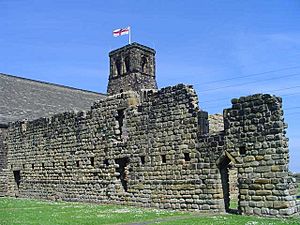Monkwearmouth–Jarrow Abbey facts for kids
Monkwearmouth–Jarrow was a special place in early England. It was actually two English monasteries that worked together as one big community. Both were started by a man named Benedict Biscop.
The first monastery, Monkwearmouth, was built in a grand Roman style. It was one of the first places in England to have beautiful stained glass windows. Later, Jarrow became a very important center for learning in northern England. It had the biggest library in Anglo-Saxon England.
A famous Anglo-Saxon scholar named Bede lived, studied, and wrote many books there. Because of their history, these two monasteries were nominated to become a World Heritage Site in 2011.
Contents
History of the Monasteries
Founding the Monasteries
In the year 674, Benedict Biscop, a nobleman from Northumbria, built the first monastery. It was called Monkwearmouth. King Egfrith of Northumbria gave him land near the River Wear. This monastery was dedicated to Saint Peter. It became known as St. Peter's at Monkwearmouth.
Benedict wanted his monastery to be a place for both learning and religion. He brought skilled stonemasons from Francia (modern-day France) to build it. Monkwearmouth was the first stone church in England. Jarrow was the second.
Benedict also brought glassmakers from Francia. They made beautiful stained glass for the church windows. A workshop was set up right there at Monkwearmouth. The monastery was finished in just one year.
In 678, the Pope agreed that the monastery would be free from outside control. Benedict collected many important religious items. He found some locally and bought others from Francia and Rome.
Jarrow and Bede
In 682, King Egfrith gave Benedict more land for a second monastery. This one was at Jarrow, near the River Trent. The dedication ceremony for Jarrow abbey happened on April 23, 685. It was named for Saint Paul.
Benedict put Ceolfrith in charge of the new Jarrow monastery. Bede, who was about ten years old, was one of the monks who went with him. The two monasteries were only seven miles apart. They were always thought of as one single community.
The amazing library that Benedict started helped Bede write his famous books. One of his most important works was Ecclesiastical History of the English People. There was no other library like it in England.
By the time Benedict died in 689, he had traveled to Rome four times. Each time, he brought back large collections of books. Ceolfrith, the fourth abbot, helped even more. He doubled the size of the library. This made Bede's work possible.
The Scriptorium and Viking Raids
The writing workshop, called a scriptorium, at Monkwearmouth-Jarrow was very busy. There was a high demand for copies of Bibles and other books. People from other parts of England and Europe wanted copies of Bede's works.
Books from this scriptorium were found in places like Russia and Rome. Because of all the requests, the scriptorium started using a faster writing style.
In 794, the Vikings attacked Monkwearmouth and Jarrow. This happened just one year after they attacked Lindisfarne. The fires were so hot that the glass melted. Both monasteries were left empty for a while. Their location on the coast made them easy targets for Viking raids.
The twin monasteries were rebuilt later. Today, you can still see parts of the old walls of Monkwearmouth and Jarrow. They are next to or part of the modern buildings that replaced the original ones from 674 and 682.
Images for kids
-
An illumination of Christ in Majesty, surrounded by the Four Evangelists, at the start of the New Testament in the Codex Amiatinus written at Monkwearmouth-Jarrow
-
A page of the Saint Petersburg Bede written at Monkwearmouth-Jarrow. National Library of Russia, St Petersburg.






